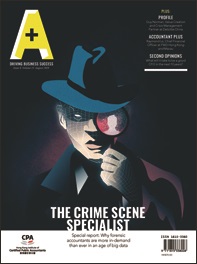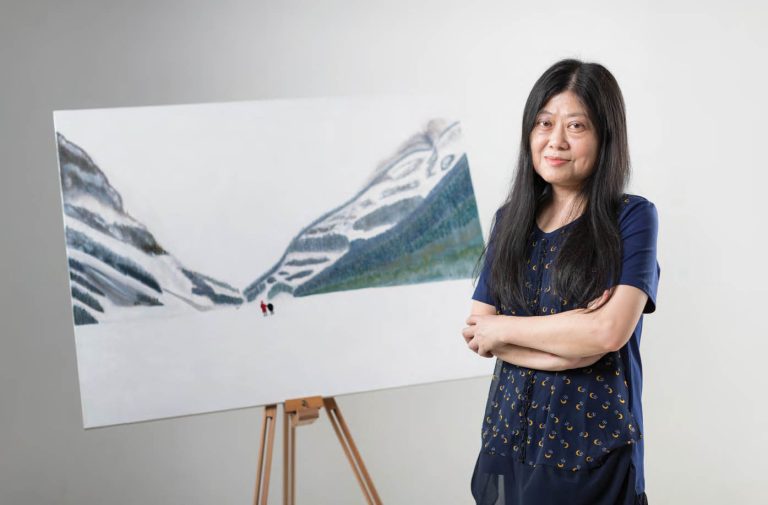Angel Lai wanted to try her luck at making a wedding dress from scratch. With only a few months’ of sewing experience – and her big wedding day only a few months away – she put aside her usual set of colour pencils and paint to focus on bringing her dress to life.
Little did she know how challenging it would be.
Lai began the project by sourcing silk and cotton in various fabric stores in Sham Shui Po for her wedding dress. She admits it was a wild idea, though deemed it a worthy challenge. “For many people, getting married only happens once in a lifetime, so I saw this as a rare opportunity to put my sewing skills to work,” says Lai, Assistant Vice President of Shanghai Commercial Bank (Financial Control Division), and a member of the Hong Kong Institute of CPAs.
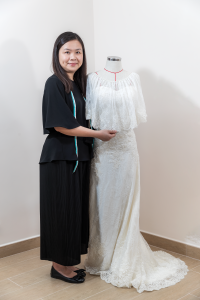
Angel Lai and the wedding dress she stitched together and wore on her wedding day.
With the fabrics ready and a sewing book, Lai took careful measurements of herself and began stitching away. She remembers how nervous she was at the beginning. “Aside from the basic sewing skills I had learned when I was a child, I hadn’t sewn anything in the last 20 years.” she says.
She produced a rough sample of the dress, but wasn’t satisfied. “I sought advice from a friend who rents wedding gowns and also teaches people how to make their own, I went to her every week.” With all that guidance, Lai felt more confident about her skills and came up with a more accurate and fitting sample of the dress.
Over the next few months, she would head straight home from the office to work on her wedding dress, and often spent most weekends stitching away. “I’d go home, have a quick dinner, and start sewing,” she adds.
Though she had sewn more casual clothing before, Lai admits it was a challenge making sure her own wedding dress would be ready for the big day, and made well. “It’s completely different from sewing a T-shirt,” she says. Working with fragile fabrics, like silk, made it even more frustrating at times. “It is one of the most difficult fabrics to work with, because it’s so soft – one wrong stitch will leave permanent holes in the material, so you have to handle it with a lot of care,” she adds.
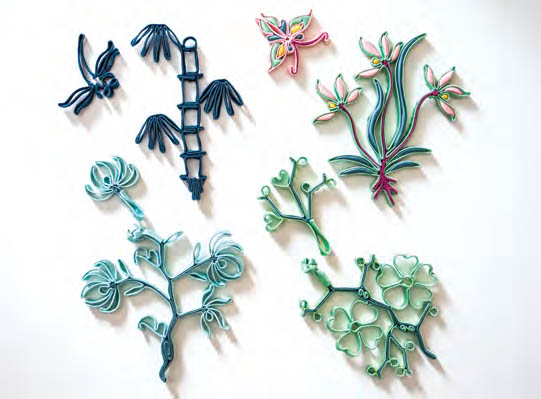
Lai’s Shanghai-style Chinese knots. Orchid and Butterfly (top right), Bamboo and Dragonfly (top left), Plum Blossom (bottom right) and Chrysanthemum (bottom left)
The ivory-coloured wedding dress began to take shape with each passing week, and in four months, Lai had done it. “I fully enjoyed doing it – and saved a lot of money doing it, too,” she says, adding that typical wedding dresses can cost upwards of HK$10,000. But Lai wasn’t ready to stop there. “I made a Chinese-style red and gold evening gown for my mother-in-law using similar materials,” she says. “I also made a bow tie for my fiancé.”
Lai’s passion for sewing has flourished since completing that wedding dress. She now focuses on making traditional Chinese-style dresses, or Cheongsam, and even took courses at the University of Hong Kong in Cheongsam design. She also learned to make Shanghai-style knots and buttons which are used to decorate the traditional dresses. When she isn’t sewing, or making Shanghai-style Chinese knots, she likes to bring her painting tools with her as she travels through countries such as Japan and South Korea, and to relax and paint picturesque landscapes and neighbourhoods. “Art is a way for me to express my ideas,” Lai says. “When I’m working on a piece of art, I’m fully focused on it, and I absolutely love the feeling of completing it.”
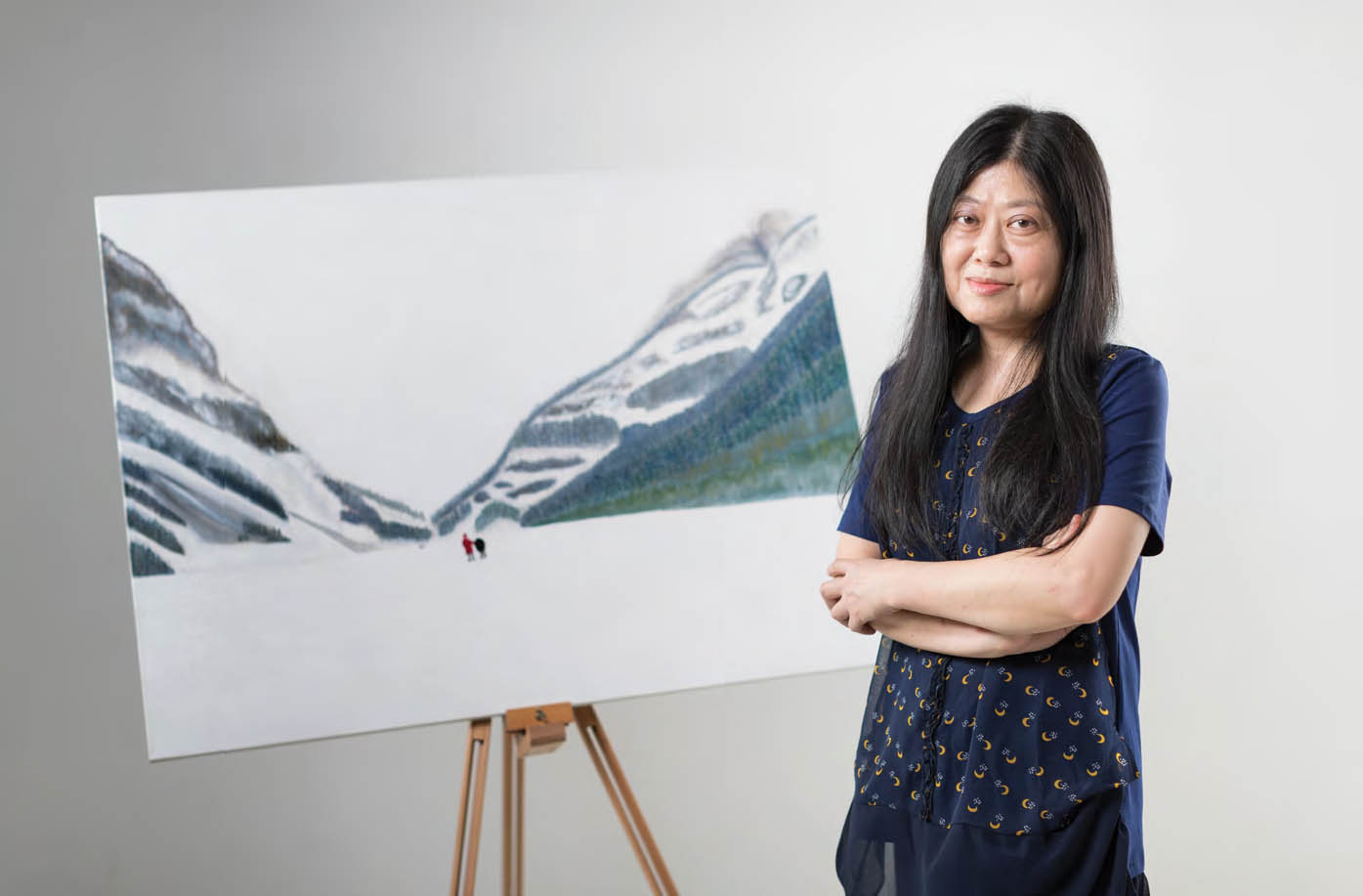
Cathy Cheng with her painting Support (Lake Louise).
Art for all to see
Cathy Cheng simply cannot imagine life without art. Her passion for painting and sketching all began at a very young age. “I was always attracted to colours found in nature,” she says. “Back in school, I would paint as soon as I finished all my homework, and I wouldn’t worry about whether the drawing was good or not – I just liked creating art.”
Cheng, Finance Manager at PLDT Global Corporation and an Institute member, enjoys doing both Western-style art, Chinese-style watercolour paintings and mixed media art, which combines a variety of media such as acrylic, watercolour or colour pencil in a single artwork. Over the last decade, she has completed a number of self portraits and landscape paintings.
Some of her artwork have been on display at local art exhibitions organized by the Eternity Chinese Painting and Calligraphy Association (ECPCA). Her painting, Support (Lake Louise), was on display in 2011, while Concentrated and The Historical Trails of Hong Kong were shown last year. Her latest piece, A Corner of A Park, is currently on display at an exhibition organized by the Hong Kong Art Researching Association.
The Historical Trails of Hong Kong is a series of six paintings showing the transformation of Hong Kong over the last century in famed districts such as Tsim Sha Tsui and more residential areas such as Shek Kip Mei. Painting it, Cheng says, was half the battle.
She had to find the most authentic photos of old Hong Kong. “I spent an entire month finding the right images online and by visiting many bookstores, libraries and also contacting government departments for images.” Her research would often bring her written descriptions of old Hong Kong, but no photo accompanying it. “Based on text, I simply had to picture and draw what I saw in my mind,” she says, adding how she often paints without drafting a sketch first. “And sometimes, I’ll paint a mix of what is real and what is imagined.” She dedicated weekends to completing the six-painting project, and finished it in two months.

Cheng’s dual self-portrait painting Concentrated
.
Balancing accounting and painting inspired Cheng to come up with a dual self-portrait painting called Concentrated. She wanted the two acrylic paintings to show how people use their left brain to perform logical and mathematical tasks, and their right brain for situations which require imagination, art and intuition. She has also painted a portrait of one of her favourite artists, Leonardo DaVinci.
When Cheng isn’t painting, she enjoys going to art exhibitions in Hong Kong such as Art Basel, Art Central, Sotheby’s and Christie’s, or simply flicking through art books and magazines for inspiration. “I want to connect with art every day, and at every opportunity,” she says, adding how she has attended Art Basel each year since its first installation in 2013.
Cheng is looking forward to having her artwork on display next February at another exhibition organized by the ECPCA, and has plans to complete a new painting within the next few months.
“I’m thinking of doing a Chinese painting this time, with Chinese ink. I’ve been doing that a lot.” Though she feels rushed to complete a work of art in time, which also meets her personal standards, she sees it as a fun challenge. “There are times you wish your artwork was better – but seeing your work on display always feels great.”
Keeping the art alive
Charles Chow was introduced to the art of Cantonese opera when he was a child by his grandfather, who would organize Cantonese opera events and bring him to meet the performers backstage.
“My younger brother and I also didn’t have many toys growing up, but we had a shelf full of ancient novels and books related to Chinese history and poetry,” he says. As he grew up, he would read and study the books, realizing how closely connected the tales were with the Cantonese opera plays he had seen. “Watching Cantonese opera helped me to understand what was written in the books,” he adds. “If you carefully listen and even study Cantonese opera lyrics, you start to understand how well written and beautiful they really are – a lot of it is poetry. Every time I heard something new, I wanted to know more.”
“My younger brother and I also didn’t have many toys growing up, but we had a shelf full of ancient novels and books related to Chinese history and poetry.”
Engrossed with the sound, movement, visuals and the meaning behind each performance, Chow actively attended Cantonese opera plays all through his school years and did his own research on the story behind each show. His passion for the art form never faded, even after he came out to work.
Chow, Managing Director of Chowson Secretarial Services Limited and an Institute member, joined the Hong Kong Academy for Performing Arts (HKAPA) in 2007. He established the HKAPA Young Academy Cantonese Opera Troupe in 2011, which trains students in Cantonese opera performance before entering the industry. He worked as a treasurer of the HKAPA’s council up from 2010 until 2015, also chaired the Cantonese Opera Advisory Committee until 2016, and became an honorary fellow in 2017. He and a team introduced the four-year Bachelor of Fine Arts (Honours) in Chinese Opera degree at the HKAPA – the world’s first degree programme in Cantonese opera. But, as Chow recalls, it wasn’t an easy journey.
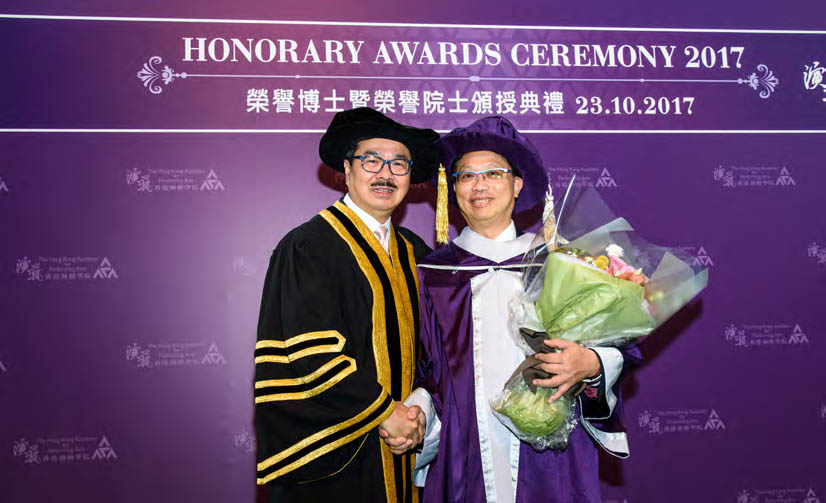
Charles Chow (right) became a fellow at the Hong Kong Academy for Performing Arts in 2017.
Though the HKAPA had been offering Cantonese opera diploma programmes since 1999, he knew that introducing an actual degree would help nurture the next generation of performers, and preserve the traditional art form.
“We spent a few years pushing the government to approve this programme before we got the green light.” A lack of budget was one of the main hurdles, but Chow and his team’s persistence eventually paid off. They received government approval for the programme, which officially began in September 2013.
Chow attends the Cantonese opera productions at the HKAPA where he meets with the instructors to discuss improvements and also gives advice to student performers, who he says, are all very enthusiastic and talented. He says many of the students came to know Cantonese opera through a relative, and came from a background in performing arts. They view the programme as a means to enrich their skills and as a stepping stone into the professional world. “This was the aim of the degree – to combine different forms of art and create something new,” he says. “The preservation of this traditional art form and nurturing young talents should not be confined to just learning stage performing skills.” Chow adds how in addition to being actors or performers, students can consider becoming Cantonese opera critics, make-up artists, stage-setting designers or scriptwriters.
Now semi-retired, Chow dedicates more time to helping out at the HKAPA. One of his plans includes working with the performing arts school to fuse western instruments with Chinese opera music, and vice versa. “We are always thinking about ways to promote Chinese opera among the younger generation,” he says.
Chow is proud to see the degree programme grow, and with the success of it, he is looking at expanding even more. “We are working on introducing a Master’s degree in Cantonese opera.”
The Hong Kong Museum of Art is set to reopen in November after being closed since 2015 for renovation works which will expand the seven-gallery museum by more than a third in size.







